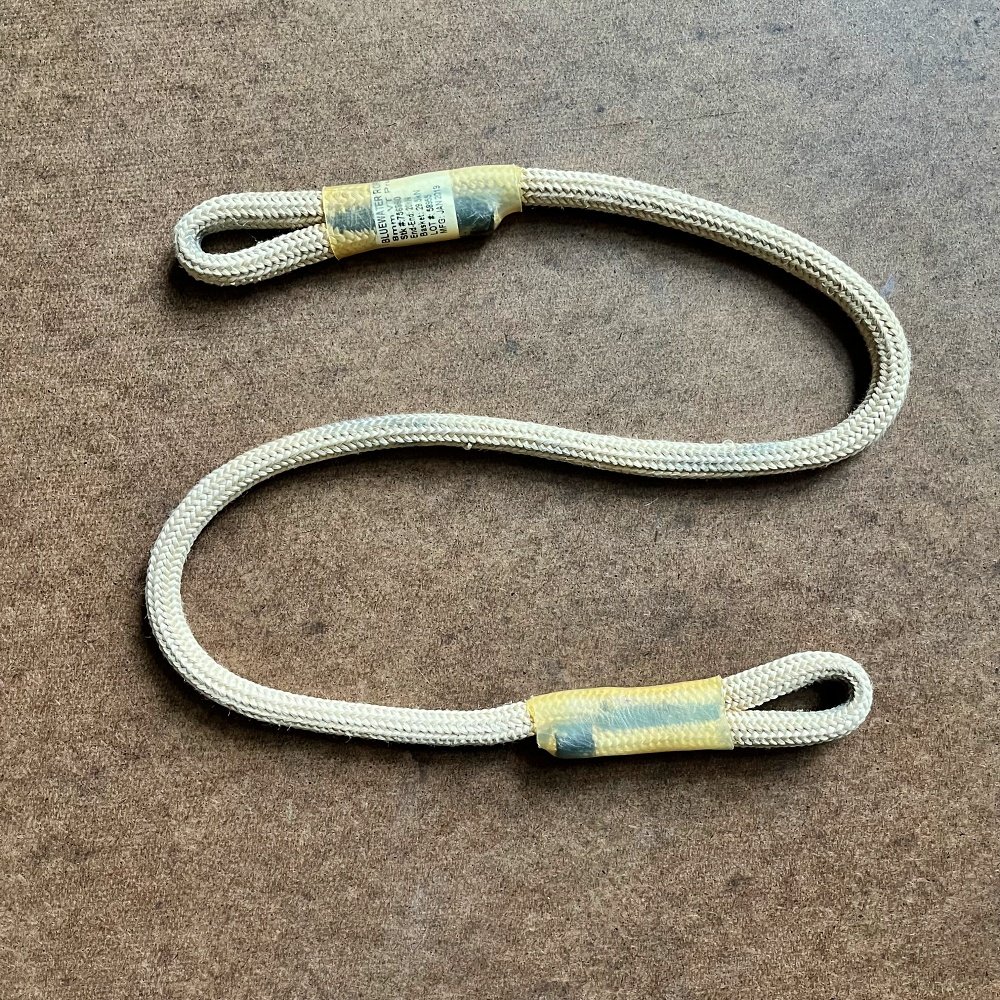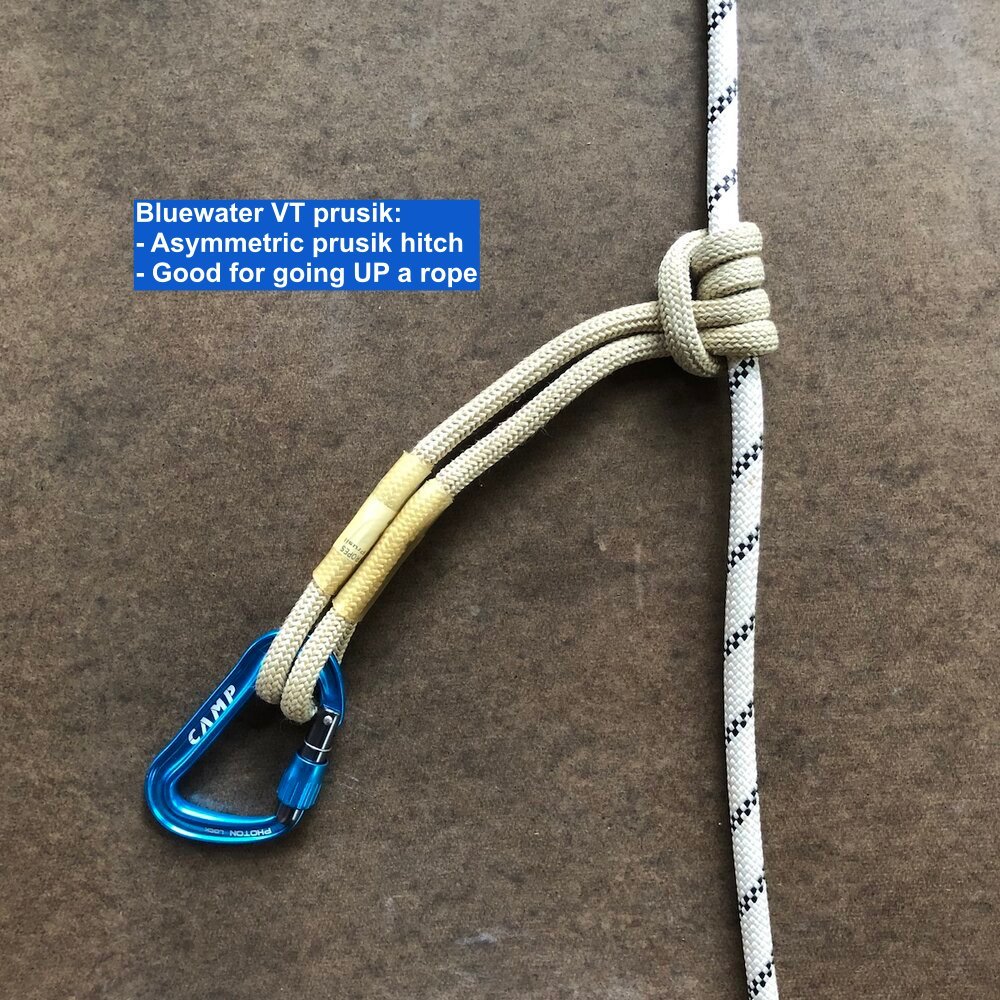Meet prusik 2.0 - the "VT" prusik
SAR teams, arborists and riggers have been using what's called “eye to eye” hitch cord for a long time. Traditionally, the eye to eye hitch was tied with a length of medium sized cord, such as 7 mm, with a couple of loops tied in each end. A modern version has a sewn eye on each end; there are various flavors made by different manufacturers.
This handy piece of gear is becoming more popular for canyoneering and recreational climbing. It can be used to tie a directional friction hitch, but it has some big advantages over the traditional perlon cord prusik loop.
Canyoneering expert Rich Carlson designed a version he calls the “VT Prusik”, and it’s pretty slick.
Made by Blue Water Ropes
Costs about $25
About 33 inches/84 cm long
End-to-end strength is about 20 Kn, and basketed it’s about 30 kN.
Comes in both 8 mm and 7 mm flavor. The 8 mm is intended for ropes between 8 and 13 mm, and the 7 mm works on ropes between 8 and 9.5 mm. (Yes, you can use an 8 mm VT on an 8 mm rope, which is kind of amazing.)
Technora (similar to Kevlar) sheath and a nylon core. (Won't melt on your rope, even if you rappel like a special forces cowboy.)
Bluewater removed some of the sheath fibers, which makes it a bit thinner, so it flattens more on the rope. This helps it grip better in some configurations.
“VT” stand for “Valdotain Tresse”. I learned from @notlufton (in an Instagram comment) the origin of this interesting term. “Valdôtain” is a dialect of Arpitan spoken in the Aosta Valley in Italy, and “Tresse” means braid in German. (There you go, I becha you learned something new today. =^)
The Valdotain Tresse / VT is one of many different types of hitches you can tie with this tool.
(The word “prusik” can be confusing because it's a verb, adjective, noun, and surname. Same with the term “VT prusik”. The VT is specific type of knot, which is a different knot than a prusik, but Bluewater chose this name for one thing they sell and . . . Yes it's kind of confusing, so let’s not get too hung up on the terminology.)
So, what’s cool about the VT prusik?
The main benefit is that you can tie various friction hitches that both grab tight and release easily. This eliminates the two main problems with the traditional prusik knot - cinching down hard on the rope when under load, and then wrestling to release it when you need to.
Let’s look at some ways to rig the VT prusik.
There are lots of fancy knots, with exotic names, you could tie with the VT prusik. Here are two of the more common ones:
The asymmetric prusik for moving upwards, or hauling anything in an UPWARD direction, like a progress capture.
The Valdotain Tresse aka “VT hitch” for moving DOWNWARD on the rope, like for a rappel backup. (With certain cautions, more below.)
1) You can make a “asymmetric” prusik, which allows you to move the prusik UP the rope much more easily after it’s been weighted. This knot works best in any situation when you need to move UP the rope. (This is also known as a “Schwabisch” hitch.)
Note: unlike a symmetric prusik, which holds equally well in either direction, an asymmetric prusik like this holds best on the rope when pulled in one direction. This is handy if you want a hands-free, one direction rope grab to protect you on a fixed line in fairly easy terrain.
2) You can tie a Valdotain Tresse hitch, which has a few unique qualities. Even when it's fully loaded with your bodyweight, you can still release the hitch. This can be useful in some situations using it as a rappel backup ABOVE your device, such as if you know that you need to pass a knot on a single strand rappel; admittedly a pretty rare situation. (If you have a double rope rappel, you should never have to pass the knot at all, as I cover in this article.)
However, most of the time, it's best practice to have your rappel backup BELOW your extended rappel. If you have it above, it's possible that you can unintentionally squeeze the hitch when you need it to serve as a backup, which usually means it's not going to fully catch on the rope. Many accidents have happened this way; more info in this article.
You can use the Valdotain Tresse hitch for ascending. But you lose a few inches of slack every time you weight the hitch, and it’s harder to slide up the rope due to the increased friction from the extra wraps. That’s why the asymmetric prusik mentioned above is usually is a better choice for ascending a rope.
Check this link to see an “animated knot” sequence of how to tie it.
Here's one other way you can tie a friction hitch. It's sort of a French prusik / autoblock.
You can also tie more traditional friction hitches like the standard three wrap prusik, or an autoblock / French prusik / Machard.
Nice! How else can I use the VT prusik?
The VT hitch can be used as a rappel backup attached ABOVE your rappel device. Normally you wouldn’t do this, but because you can release the VT hitch under tension, it works fine. As mentioned above, use caution with this method; if you grab it in an emergency it may not work correctly.
In the unlikely event you might ever need to “rappel” a rope that’s under tension, a VT hitch lets you do this, because it's releasable even when loaded.
You can use it to more easily pass a knot, again, because you can slide the prusik even when it's holding your full body weight. (Side note: you should pretty much never have to pass a knot if you set up your rigging correctly.)
You can use it as a third hand / French prusik / autoblock backup beneath your rappel device anytime you’re doing a lower or rappel (similar to a Sterling Hollow Block). The VT prusik lets you more easily fine tune the amount of friction than a loop style autoblock. Note, it’s best to do this with a rappel extension.
You can use it as a quick draw, either halved or at full extension.
You can use it as a personal lanyard; clip one end to a locking carabiner or quick link on your harness and the other end to a locking carabiner.
In a hauling system, like for 3:1 “Z drag”, you can use it as a progress capture device on a non-prusik minding pulley. Because of its width, the VT prusik is less likely to get sucked into the pulley like a standard prusik loop. See image below.
Sweet! Where do I get one?
As with most aspects of rope work, it's a better show than to tell. Watch this YouTube video below made by Rich Carlson, the inventor, for a complete review of his clever tool.
Finally, here's a nice video from our friends at HowNot2.com doing some break testing and general shenanigans with the VT prusik.






